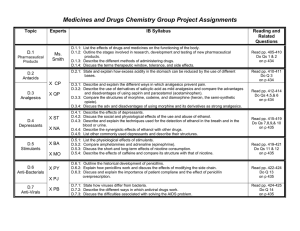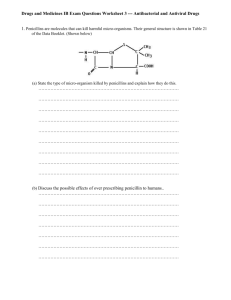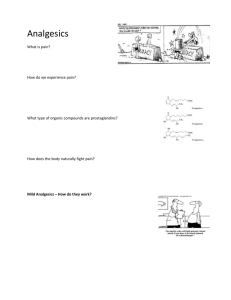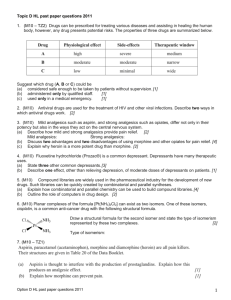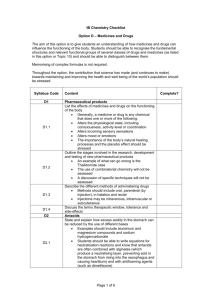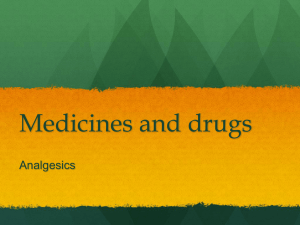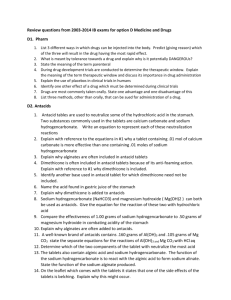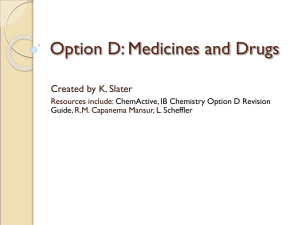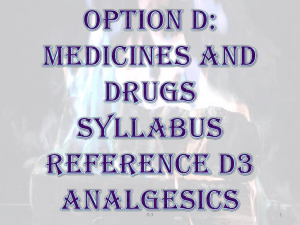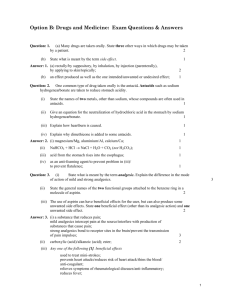Option D past paper questions wiki version
advertisement
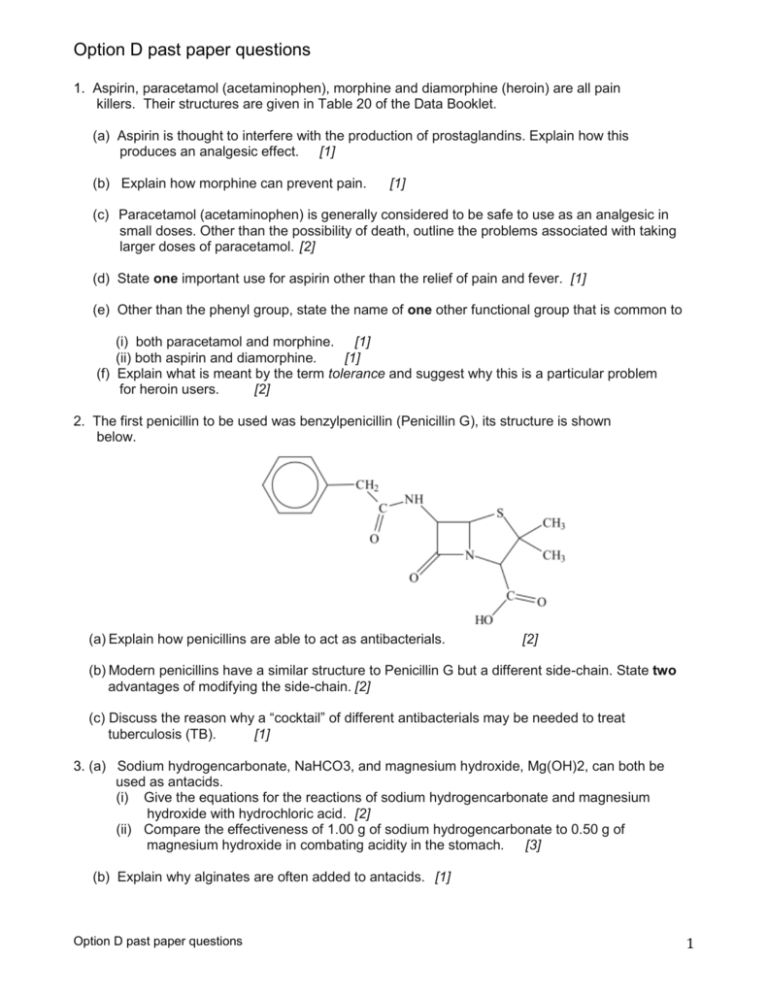
Option D past paper questions 1. Aspirin, paracetamol (acetaminophen), morphine and diamorphine (heroin) are all pain killers. Their structures are given in Table 20 of the Data Booklet. (a) Aspirin is thought to interfere with the production of prostaglandins. Explain how this produces an analgesic effect. [1] (b) Explain how morphine can prevent pain. [1] (c) Paracetamol (acetaminophen) is generally considered to be safe to use as an analgesic in small doses. Other than the possibility of death, outline the problems associated with taking larger doses of paracetamol. [2] (d) State one important use for aspirin other than the relief of pain and fever. [1] (e) Other than the phenyl group, state the name of one other functional group that is common to (i) both paracetamol and morphine. [1] (ii) both aspirin and diamorphine. [1] (f) Explain what is meant by the term tolerance and suggest why this is a particular problem for heroin users. [2] 2. The first penicillin to be used was benzylpenicillin (Penicillin G), its structure is shown below. (a) Explain how penicillins are able to act as antibacterials. [2] (b) Modern penicillins have a similar structure to Penicillin G but a different side-chain. State two advantages of modifying the side-chain. [2] (c) Discuss the reason why a “cocktail” of different antibacterials may be needed to treat tuberculosis (TB). [1] 3. (a) Sodium hydrogencarbonate, NaHCO3, and magnesium hydroxide, Mg(OH)2, can both be used as antacids. (i) Give the equations for the reactions of sodium hydrogencarbonate and magnesium hydroxide with hydrochloric acid. [2] (ii) Compare the effectiveness of 1.00 g of sodium hydrogencarbonate to 0.50 g of magnesium hydroxide in combating acidity in the stomach. [3] (b) Explain why alginates are often added to antacids. [1] Option D past paper questions 1 4. State the differences between the structures of morphine and diamorphine (heroin). State the names of all functional groups in the molecule of morphine. [3] Differences: Functional groups: 5. Bacterial and viral infections require different types of medication. (a) Outline two differences between bacteria and viruses. [2] (b) Antiviral drugs are used for the treatment of HIV and other viral infections. Describe two ways in which antiviral drugs work. [2] (c) Discuss why viral infections are generally harder to treat than bacterial infections. [3] 6. Mild analgesics such as aspirin, and strong analgesics such as opiates, differ not only in their potency but also in the ways they act on the central nervous system. (a) Describe how mild and strong analgesics provide pain relief. [2] Mild analgesics: Strong analgesics: (b) Discuss two advantages and two disadvantages of using morphine and other opiates for pain relief. [4] Advantages: Disadvantages: 7. Fluoxetine hydrochloride (Prozac®) is a common depressant. Depressants have many therapeutic uses. (a) State three other common depressants. [3] (b) Describe one effect, other than relieving depression, of moderate doses of depressants on patients. [1] 8. (a) Alexander Fleming, Howard Florey and Ernst Chain shared the Nobel Prize for “the discovery of penicillin and its curative effect in various infectious diseases”. (i) Outline the contributions of Fleming, Florey and Chain to the development of penicillins. [2] Fleming: Florey and Chain: (ii) Describe the mode of action of penicillins in treating infectious diseases. [2] (b) Ampicillin is a semi-synthetic penicillin used to treat lung infections. The structure of the antibiotic is shown below. Option D past paper questions 2 (i)Identify two functional groups present in the side chain (R) of ampicillin by comparing its structure to that of penicillin in Table 20 in the Data Booklet. [2] (ii) Explain why it is important to continue to develop semi-synthetic penicillins. [2] 9. (a) Explain the meaning of the terms: (i) side-effect [1] (ii) therapeutic window (ii) placebo effect. [1] [1] (b) The effectiveness of a drug depends on the method of administration. (i) One method of injecting drugs into the body results in the drug having a very rapid effect. State the method and explain its rapid action. [2] (ii) List the two other methods which can be used to inject drugs into the body. [1] (iii) Identify the method of administration used to treat respiratory diseases such as asthma. [1] 10. Amphetamine and methamphetamine are widely abused drugs. (a) State one short-term effect of amphetamine on the human body. [1] (b) Explain why amphetamine is classified as a sympathomimetic drug and relate this to its structure. [2] (c) Regular use of amphetamine and methamphetamine can lead to tolerance. Explain why this is potentially dangerous. [2] 11. Analgesics are used to relieve pain in the body. Aspirin and paracetamol (acetaminophen) are both mild analgesics. (a) Discuss the advantages of using aspirin instead of paracetamol. [2] (b) Compare how mild and strong analgesics relieve pain in the body. [2] (c) The structures of the strong analgesics morphine and heroin (diamorphine) can be found in Table 20 of the Data Booklet. (i) Identify the amine functional group in the morphine molecule below by drawing a ring around it [1] (ii) Classify the type of amine present in morphine. [1] (iii) State the name of the functional group found in heroin but not in morphine. [1] Option D past paper questions 3 (d) State one advantage and one disadvantage of using morphine as a strong analgesic. [2] 12. Medicines and drugs alter the physiological state of the body including consciousness and coordination. (a) State one other effect of medicines and drugs on the body. [1] (b) Explain the meaning of the following terms: (i) therapeutic window. [1] (ii) tolerance. [1] (iii) placebo effect. [1] (c) Outline the major stages in the development of a new drug. [3] 13. Ethanol is a depressant that is widely consumed in many societies. When consumed excessively it has a major impact on families and society as a whole. Other depressants such as diazepam (Valium®) may be prescribed by a doctor. (a) Describe the effect on the individual of consuming depressants at moderate and high doses. [2] (b) One problem associated with ethanol consumption is an increased risk of traffic accidents. Police in many countries use a breathalyser to test drivers. The breathalyser contains potassium dichromate(VI). (i) Describe the colour change of potassium dichromate(VI) when it reacts with ethanol. [1] (ii) State with a reason whether chromium in potassium dichromate(VI) is oxidised or reduced by ethanol. [1] 14. Medicines and drugs can influence the functioning of the body. Discuss the term therapeutic window. Your answer should include its meaning, a quantitative description and an explanation of wide and narrow therapeutic windows. [4] 15. The walls of the human stomach contain cells that produce gastric juices. Sodium hydrogencarbonate is an antacid often used to neutralize excess acid. [4] (a) State an equation for the reaction of stomach acid with this antacid. [1] (b) Calcium carbonate can also neutralize stomach acid. The same amounts (in moles) of sodium hydrogencarbonate and calcium carbonate are available. Deduce which antacid will neutralize the greater amount of acid present in the stomach and explain your reasoning. [2] Option D past paper questions 4 16. Ethanol, a depressant, is sufficiently volatile to pass into the lungs from the bloodstream. The roadside breathalyser test uses acidified potassium dichromate(VI) which reacts with any ethanol present in the breath and converts it to ethanoic acid. (a) (i) State the oxidation and reduction half-equations that occur in the breathalyser when ethanol is present in the breath. [2] Oxidation: Reduction: (ii) Describe the colour change that occurs to the acidified dichromate(VI) if ethanol is present in the breath. [1] (b) Police use the intoximeter, an infrared spectrophotometer to confirm a roadside breathalyser test. Explain how the amount of ethanol is determined from the infrared spectrum. [2] 17. Antibacterials are drugs that kill or inhibit the growth of microorganisms that cause infectious diseases. The general structure of penicillin, an antibacterial, is given below. (a) With reference to the structure above, state what the letter R represents and discuss how penicillins can be made more resistant to the penicillinase enzyme. [2] (b) Describe and explain one effect of overprescription of antibacterials. [2] 18. Describe and explain difficulties associated with solving the AIDS problem. Option D past paper questions [4] 5
